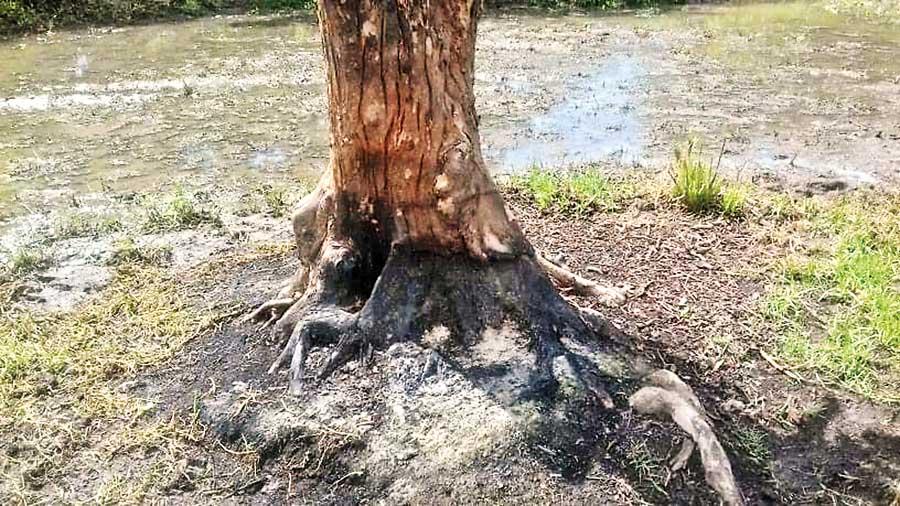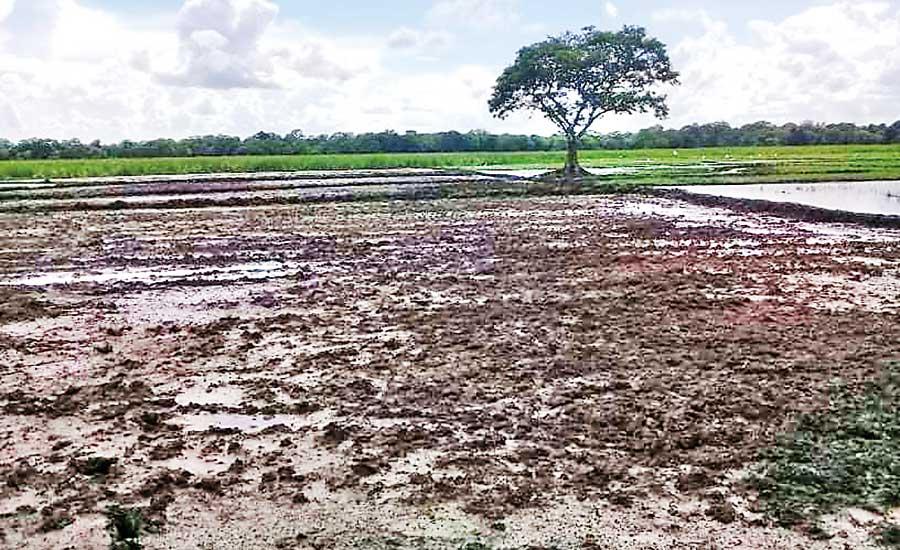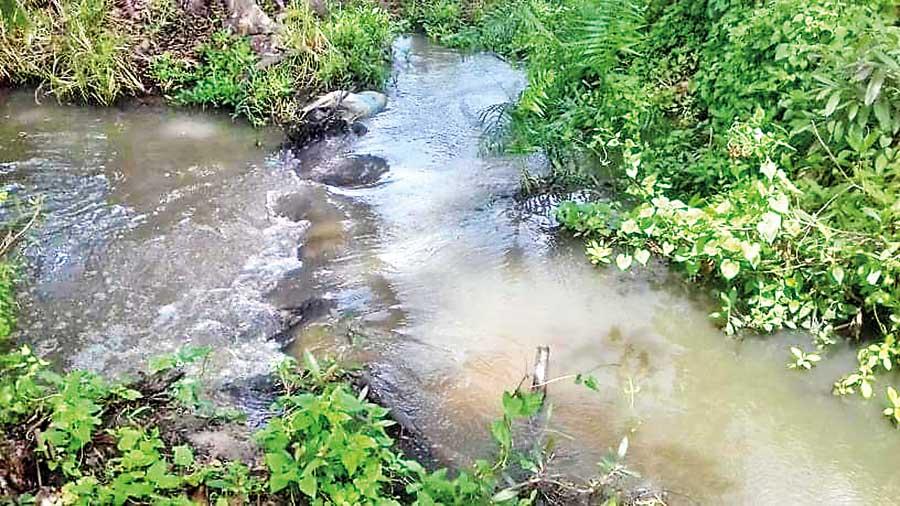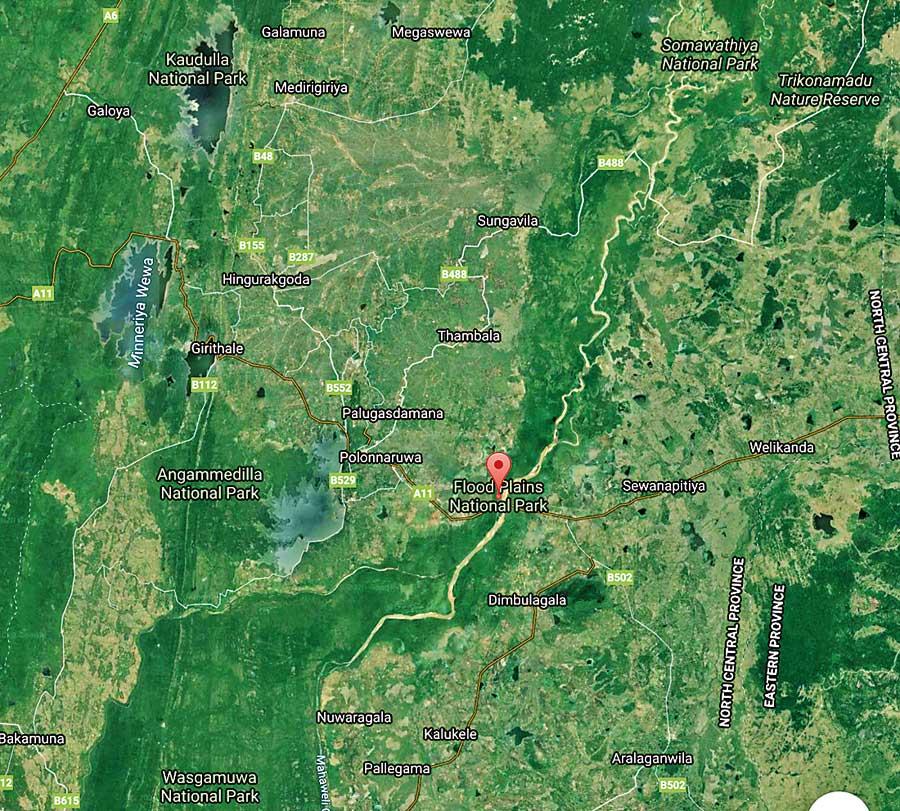22 May 2020 - {{hitsCtrl.values.hits}}

Tree roots burnt
Spanning 17,300 hectares of land, the Flood Plains National Park sits in a prominent location in the Polonnaruwa District. Surrounded by the Kaudulla, Angamedilla and Somawathiya National Parks and the Triconamadu Nature Reserve, the Park is home to many species of endemic Flora and Fauna. Blessed with over 38 villus, the Park,  therefore, has been recognised as an important wetland ecosystem, especially one that helps to maintain the water table. However, continuing encroachment and unapproved farming activities on these villus have posed a threat to the entire ecosystem.
therefore, has been recognised as an important wetland ecosystem, especially one that helps to maintain the water table. However, continuing encroachment and unapproved farming activities on these villus have posed a threat to the entire ecosystem.
The rich vegetation in the villus attract an abundance of grazing animals and birds and supports higher annual biomass than any other type of habitat within the Mahaweli development project area. The Flood Plain with their abundant supply of water and grasslands is a feeding ground for mammals while the marshes support large populations of reptiles. The Flood Plains are particularly important for the diversity and abundance of avifauna, where it has been estimated that around 75 species of migrant species spend their wintertime in the marshes of the Flood Plain.
"People remove tree barks and leave them to die. Then they burn roots and bring
the trees down. The area is blessed with many dry zone Flora and Fauna and all these species are now under threat" - Jayantha Wijesinghe, Convener of Rainforest Protectors Sri Lanka

Villus turned into muddy areas
According to T. Theepan representing the Organisation to Protect Flood Plains National Park, around six villus have been destroyed due to illegal paddy cultivations. “These include Karakola, Alinchipathaana, Muthugala, Kokkuvilluwa, Katuwanwala and Divulana villus situated within the National Park. Usually, these are feeding grounds for elephants and wild animals within the park. Since elephants don’t have anything to feed on within the National Park they charge into nearby villages. But if these villus are protected, the human-elephant conflict in the area could be minimised to a greater extent.”
Further explaining how a villu is converted to a farming ground, Theepan said that these farmers firstly cut a waterway from the villu to reach the nearby Mahaweli River. Thereafter, water gets diverted to the river and during the dry season the villus dry out. Afterwards, they dig the villu bed and use it as a paddy farming ground. This is a complete violation of the Environmental Act because villus are within a protected area and it is a sensitive ecosystem. However, these farmers claim that the said areas do not come under the purview of the Department of Wildlife Conservation (DWC). Moreover, the permits and deeds to do farming practices were issued by the Mahaweli Authority. They claim that they have been farming in these areas for over 20-30 years but the deeds were issued during 2016, 2017 and some were even issued earlier this year as well.”

Manmade waterway diverting water from a villu to the Mahaweli River
Adding on to what Theepan said, Jayantha Wijesinghe, Convener of Rainforest Protectors Sri Lanka said that the National Park had been subjected to massive encroachments by villagers over the recent past. “People remove tree barks and leave them to die. Then they burn roots and bring the trees down. The area is blessed with many dry zone Flora and Fauna and all these species are now under threat. We were also told that farmers in Welikanda and Thamankaduwa areas have requested the divisional secretaries to remove elephant fences so that they could further expand their paddy cultivations. They have also asked authorities to release these areas from protected area status. Some cattle farmers send their cattle inside the Park so that they have an abundance of grass and other plants to feed on. Therefore elephants are further deprived of food and therefore charge into the villages. Illegal farming activities continue in areas such as Punagama, Alimulla, Veheragodayaya, Divulana and Manikkapitiya.”
"If Section 6 is violated, a perpetrator could be arrested without a warrant and it is a non-bailable offence" - Environment lawyer Jagath Gunawardena

The Park surrounded by several other protected areas
This area was declared as a National Park on August 7, 1984 (Gazette Notification No. 309/4). “Since it had a
|
Charred remains of trees |
wetland ecosystem there was a need to protect it and today it is one of the most important wetlands in the country,” said a DWC officer who wished to remain anonymous. “Investigations are underway on people who have cut waterways diverting water collected in villus to the Mahaweli River. People who were carrying out illegal farming practices in Veheragodayaya have been questioned and the case will be taken up at the Polonnaruwa Magistrate Court. Since villus are sensitive ecosystems without conducting an Environment Impact Assessment (EIA) nobody is allowed to do any cultivation activities within the Park. Even if someone did issue a permit it has to follow due process. In that case, it has to be passed in Parliament and only after the ‘protected area’ status has been removed, can one commence farming practices. But within a forest reserve or a protected area, nobody can carry out personal operations whatsoever.”
He further said that the district agriculture department has also given these farmers a fertiliser subsidy. “As a result, fertilisers get washed away in the waterways and reach out to the River. Fertilisers also get deposited in these villus and grasslands around places in Handapan Villu, for example, are not suitable for gazing any more.”
Shedding light on the legal provisions, environment lawyer Jagath Gunawardena said that the area has been declared a National Park under Section 2, subsection 1 of the Flora and Fauna Protection Ordinance (FFPO). “Therefore any area declared under this section can have state land and land other than state land. According to Section 5, no person can enter or remain within a nature reserve except under the authority and in accordance with the conditions of a permit issued by the prescribed officer on payment of the prescribed fee. Section 6 refers to acts that are prohibited within a Strict Natural Reserve, National Park and other protected areas. Therefore they cannot destroy the land, make any forest clearings, clear or break up any land for cultivation, mining or any other purposes, fell, girdle, tap, burn or in any way damage or destroy any plant or take, collect or remove any plant. Therefore there are clear violations of Sections 5 and 6. If Section 6 is violated, a perpetrator could be arrested without a warrant and it is a non-bailable offence.”
"Around six villus have been destroyed due to illegal paddy cultivations"
He further said that most villus are breeding grounds for endemic fish and villus play an important role in maintaining the water table. “Therefore nobody can issue a permit and the DWC has the authority to arrest those who issue permits and produce them in courts. Due to the indefinite curfew periods, poachers and other culprits
|
Several clearings seen from Google Maps |
have found a field day to do illegal activities. The Police claim that they have arrested many curfew violators but so far I haven’t seen at least one poacher or a timber racketeer arrested. Don’t they fall into the category of curfew violators?” he questioned.
Gunawardena also said that Police officers too have the same powers as DWC officials to arrest perpetrators as mentioned in Section 66 of the FFPO. “Therefore they too are prescribed officers who have the authority to seize any vehicle, article or equipment that has been used to commit the offence.”
The Daily Mirror learned that some permits were issued by the Welikanda and Thamankaduwa Divisional Secretariats. However, when contacted, Thamankaduwa Divisional Secretary H.S.K.J Bandara said that permits cannot be issued in a buffer zone. “This area comes under the purview of the DWC. Therefore ideally nobody can issue a permit.” He then directed us to contact the Lankapura Divisional Secretary W. M. I. Karunarathna who had a different story altogether. “Most villages lie in the border of the National Park and the district agriculture office has given them permission to cultivate in one or two-acre areas of land,” he said. “We haven’t given them the approval to cultivate within the buffer zone. They are prohibited from doing that. But it seems that some of these farmers have carried out farming activities within the Park. We came across a tractor that was used for farming activities on May 17 and it has been seized. Thereafter we decided to halt the issuance of lands until we make a decision.”
However, when the Daily Mirror contacted Mahaweli Authority’s Deputy Regional Project Manager (Lands) Pubudu Janaka, he said that the boundary lies in the Mahaweli B Zone but the DWC hasn’t marked the boundaries as such. “We have issued deeds for farmers in Sewanapitiya but the DWC claims that they have encroached into the buffer zone. The boundaries are only mentioned in the gazette. If they had marked the boundaries, the farmers wouldn’t have expanded their lands. Thereafter the DWC filed a case against us and now the case is pending in courts.”
28 Nov 2024 31 minute ago
28 Nov 2024 34 minute ago
28 Nov 2024 49 minute ago
28 Nov 2024 2 hours ago
28 Nov 2024 2 hours ago